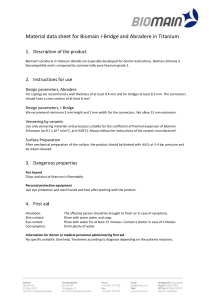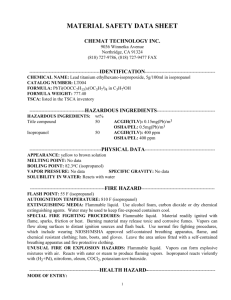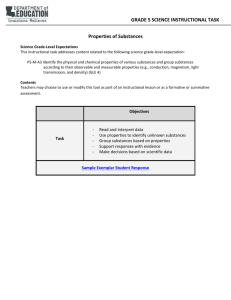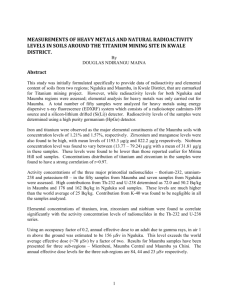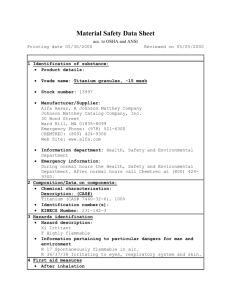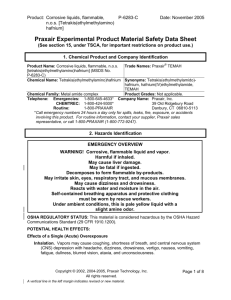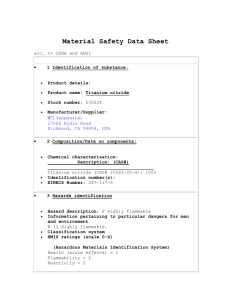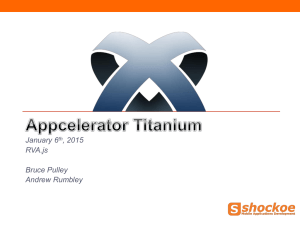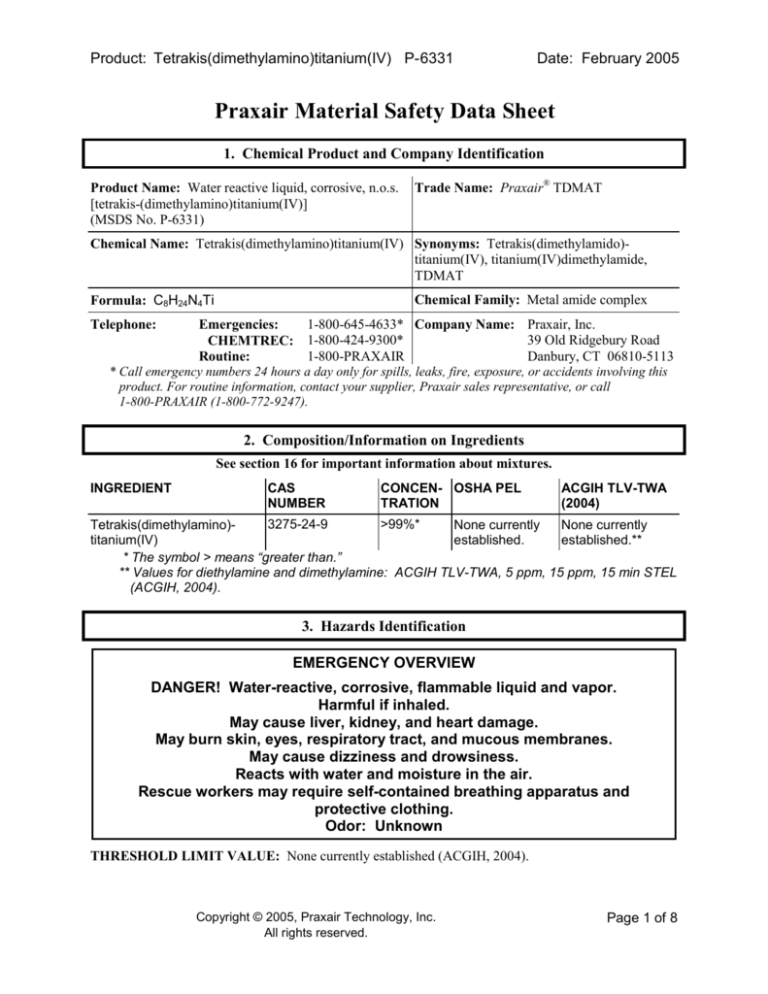
Product: Tetrakis(dimethylamino)titanium(IV) P-6331
Date: February 2005
Praxair Material Safety Data Sheet
1. Chemical Product and Company Identification
Product Name: Water reactive liquid, corrosive, n.o.s.
[tetrakis-(dimethylamino)titanium(IV)]
(MSDS No. P-6331)
Trade Name: Praxair® TDMAT
Chemical Name: Tetrakis(dimethylamino)titanium(IV) Synonyms: Tetrakis(dimethylamido)titanium(IV), titanium(IV)dimethylamide,
TDMAT
Formula: C8H24N4Ti
Chemical Family: Metal amide complex
1-800-645-4633* Company Name: Praxair, Inc.
Emergencies:
39 Old Ridgebury Road
CHEMTREC: 1-800-424-9300*
1-800-PRAXAIR
Danbury, CT 06810-5113
Routine:
* Call emergency numbers 24 hours a day only for spills, leaks, fire, exposure, or accidents involving this
product. For routine information, contact your supplier, Praxair sales representative, or call
1-800-PRAXAIR (1-800-772-9247).
Telephone:
2. Composition/Information on Ingredients
See section 16 for important information about mixtures.
INGREDIENT
CAS
NUMBER
CONCEN- OSHA PEL
TRATION
ACGIH TLV-TWA
(2004)
3275-24-9
>99%*
Tetrakis(dimethylamino)None currently
None currently
titanium(IV)
established.
established.**
* The symbol > means “greater than.”
** Values for diethylamine and dimethylamine: ACGIH TLV-TWA, 5 ppm, 15 ppm, 15 min STEL
(ACGIH, 2004).
3. Hazards Identification
EMERGENCY OVERVIEW
DANGER! Water-reactive, corrosive, flammable liquid and vapor.
Harmful if inhaled.
May cause liver, kidney, and heart damage.
May burn skin, eyes, respiratory tract, and mucous membranes.
May cause dizziness and drowsiness.
Reacts with water and moisture in the air.
Rescue workers may require self-contained breathing apparatus and
protective clothing.
Odor: Unknown
THRESHOLD LIMIT VALUE: None currently established (ACGIH, 2004).
Copyright © 2005, Praxair Technology, Inc.
All rights reserved.
Page 1 of 8
Product: Tetrakis(dimethylamino)titanium(IV) P-6331
Date: February 2005
EFFECTS OF A SINGLE (ACUTE) OVEREXPOSURE:
INHALATION–Exposure to amine vapors above the 5 ppm TLV may irritate the respiratory tract
causing sneezing, coughing, and a burning sensation in the throat. The larynx feels constricted, and
the victim has difficulty breathing. Symptoms may include central nervous system (CNS) depression
with headache, dizziness, drowsiness, vertigo, nausea, vomiting, fatigue, dullness, blurred vision,
ataxia (poor coordination), and unconsciousness. Higher concentrations may damage the liver,
kidneys, and heart and cause tracheitis, bronchitis, and pneumonitis (inflammation of the windpipe,
bronchial passages, and lungs) and pulmonary edema (fluid in the lungs).
SKIN CONTACT–Vapor may irritate the skin; liquid can cause burns. With prolonged or repeated
exposure, harmful amounts may be absorbed through the skin.
SWALLOWING–May cause CNS depression with dizziness, drowsiness, headache, dullness,
fatigue, ataxia, and unconsciousness.
EYE CONTACT–Liquid or vapor may cause mild to severe irritation with stinging sensation,
redness, pain, blurred vision, and corneal inflammation (keratitis). Chemical burns can result in loss
of vision.
EFFECTS OF REPEATED (CHRONIC) OVEREXPOSURE: Repeated or prolonged exposure of the
skin may cause dermatitis (inflammation of the skin).
OTHER EFFECTS OF OVEREXPOSURE: None known.
MEDICAL CONDITIONS AGGRAVATED BY OVEREXPOSURE: The skin-irritating properties
of tetrakis(diethylamino)titanium may aggravate an existing dermatitis. Respiratory irritation may
aggravate an existing asthma or other upper respiratory or pulmonary disease.
SIGNIFICANT LABORATORY DATA WITH POSSIBLE RELEVANCE TO HUMAN HEALTH
HAZARD EVALUATION: None known.
CARCINOGENICITY: Tetrakis(dimethylamino)titanium is not listed by NTP, OSHA, or IARC.
4. First Aid Measures
INHALATION: Immediately remove to fresh air. If not breathing, give artificial respiration. If
breathing is difficult, qualified personnel may give oxygen. Closely monitor the victim for wheezing,
coughing, or pain. Call a physician.
SKIN CONTACT: Remove contaminated clothing and shoes, and wash exposed areas with soap and
plenty of water. Wash contaminated clothing prior to reuse; discard shoes. Seek medical attention if
discomfort persists.
SWALLOWING: Keep the victim calm, and get immediate medical aid. If conscious, wash out mouth
with water. Do not induce vomiting unless directed to do so by medical personnel.
EYE CONTACT: Immediately flush eyes thoroughly with water for at least 15 minutes. Hold the
eyelids open and away from the eyeballs to ensure that all surfaces are flushed thoroughly. See a
physician, preferably an ophthalmologist, immediately.
NOTES TO PHYSICIAN: Victims of overexposure by inhalation should be observed for up to 72 hours
for delayed onset of pulmonary edema. Use of acidics to neutralize swallowed contents is
contraindicated.
Exposure to the vapor may cause minor transient edema of the corneal epithelium. This condition,
referred to as “glaucopsia,” “blue haze” or “blue-gray haze,” produces a blurring of vision against a
general bluish haze and the appearance of halos around bright objects. The effect disappears
spontaneously within a few hours of the end of an exposure and leaves no sequelae. Although not
Page 2 of 8
Product: Tetrakis(dimethylamino)titanium(IV) P-6331
Date: February 2005
detrimental to the eye per se, glaucopsia predisposes an affected individual to physical accidents and
reduces the ability to undertake skilled tasks such as driving a motorized vehicle. The hazards of this
material are mainly due to its severe irritant and corrosive properties on the skin and mucosal surfaces.
Careful gastric lavage is required. Treatment of overexposure should be directed at the control of
symptoms and the clinical condition.
5. Fire Fighting Measures
FLASH POINT (test method):
Not available
AUTOIGNITION TEMPERATURE:
Not available
FLAMMABLE LIMITS IN AIR, % by volume: LOWER: Not available UPPER: Not available
EXTINGUISHING MEDIA: CO2, dry chemical powder. Do NOT use water or water-based foams.
SPECIAL FIRE FIGHTING PROCEDURES: DANGER! Water-reactive, corrosive, flammable
liquid and vapor. May emit toxic, flammable, and corrosive fumes and vapors on reaction with water or
upon thermal decomposition. Evacuate all personnel from danger area. Use self-contained breathing
apparatus and protective clothing. Remove ignition sources if without risk. Move containers away from
fire area if without risk. If this material is on fire, extinguish flames with the recommended media. On-site
fire brigades must comply with OSHA 29 CFR 1910.156.
UNUSUAL FIRE AND EXPLOSION HAZARDS: Heat of fire may cause violent rupture of package.
Vapors may form explosive mixtures with air. May emit toxic, flammable, and corrosive fumes when
heated. Reacts with water and moisture in the air. Vapors may travel considerable distance to source of
ignition and flash back. Vapors are heavier than air and may collect in low spots.
HAZARDOUS COMBUSTION PRODUCTS: CO, CO2, titanium oxides, nitrogen oxides, and organic
fumes.
6. Accidental Release Measures
STEPS TO BE TAKEN IF MATERIAL IS RELEASED OR SPILLED: DANGER! Waterreactive, corrosive, flammable liquid and vapor. Immediately evacuate all personnel from danger area.
Use self-contained breathing apparatus and protective clothing where needed. Remove all sources of
ignition if without risk. Shut off flow if without risk. Reacts with water and moisture in the air. Vapors
may spread from leak. Vapors are heavier than air and may collect in low spots. Ventilate area or move
container to a well-ventilated area.
WASTE DISPOSAL METHOD: Prevent waste from contaminating the surrounding environment.
Keep personnel away. Small spills can be covered with vermiculite, sodium carbonate, sand, or other
compatible, noncombustible absorption material; swept up; and placed into containers for later disposal.
Discard any product, residue, disposable container, or liner in an environmentally acceptable manner, in
full compliance with federal, state, and local regulations. If necessary, call your local supplier for
assistance.
Page 3 of 8
Product: Tetrakis(dimethylamino)titanium(IV) P-6331
Date: February 2005
7. Handling and Storage
PRECAUTIONS TO BE TAKEN IN STORAGE: Store and use with adequate ventilation. Store in a
cool, dry area under inert atmosphere and away from direct sunlight. Store only in the DOT-approved
container in which product was received. Never store tetrakis(dimethylamino)titanium in open containers.
Keep containers closed. Store only where temperature will not exceed 125°F (52°C). Store full and empty
containers separately. Use a first-in, first-out inventory system to prevent storing full containers for long
periods.
PRECAUTIONS TO BE TAKEN IN HANDLING: Protect containers from damage. For other
precautions in using this product, see section 16.
For further information on storage, handling, and use, see NFPA 30, Flammable and Combustible Liquids
Code, published by the National Fire Protection Association, 1 Batterymarch Park, PO Box 9101, Quincy,
MA 02269-9101; 1-800-344-3555; www.nfpa.org.
8. Exposure Controls/Personal Protection
VENTILATION/ENGINEERING CONTROLS:
LOCAL EXHAUST–Inadequate; see SPECIAL.
MECHANICAL (general)–Inadequate; see SPECIAL.
SPECIAL–Use only in a closed system. This material is air- and moisture-sensitive. It should be
maintained under a dry, inert atmosphere and used in an enclosed device such as a glove box.
OTHER–See SPECIAL.
RESPIRATORY PROTECTION: Respirators must be acceptable to MSHA and NIOSH. Respiratory
protection must conform to OSHA rules as specified in 29 CFR 1910.134. Select per OSHA 29 CFR
1910.134 and ANSI Z88.2.
SKIN PROTECTION: Wear work gloves when handling containers; chemical resistant gloves where
contact with product may occur.
EYE PROTECTION: Wear safety glasses when handling containers. Select eye protection in
accordance with OSHA 29 CFR 1910.133.
OTHER PROTECTIVE EQUIPMENT: Protective clothing where needed. Select in accordance with
OSHA 29 CFR 1910.132 and 1910.133.
9. Physical and Chemical Properties
MOLECULAR WEIGHT:
224.19 g/mol
DENSITY:
59.12 lb/ft3 (0.947 g/cm3)
SOLUBILITY IN WATER:
Reacts with water.
BOILING POINT at 0.001psi (0.05 mm Hg):
122°F (50°C)
APPEARANCE, ODOR, AND STATE: Yellow liquid, odor unknown
Page 4 of 8
Product: Tetrakis(dimethylamino)titanium(IV) P-6331
Date: February 2005
10. Stability and Reactivity
STABILITY:
Unstable
Stable
NOTE: Tetrakis(dimethylamino)titanium is stable as shipped under a blanket of dry nitrogen or helium.
INCOMPATIBILITY (materials to avoid): Water, air, alcohol; protic solvents, oxidizers, acids; strong
bases, halogens bases, aldehydes, ketones, silicones, neoprene, and paper.
HAZARDOUS DECOMPOSITION PRODUCTS: Thermal decomposition may produce CO, CO2,
titanium oxides, nitrogen oxides, and organic fumes.
HAZARDOUS POLYMERIZATION:
May Occur
Will Not Occur
CONDITIONS TO AVOID: Ignition sources, heat, moisture, oxidizing agents.
11. Toxicological Information
See section 3.
12. Ecological Information
No data available on effects on aquatic life. Tetrakis(dimethylamino)titanium does not contain any Class I
or Class II ozone-depleting chemicals. Tetrakis(dimethylamino)titanium is not listed as a marine pollutant
by DOT.
13. Disposal Considerations
WASTE DISPOSAL METHOD: Do not attempt to dispose of residual or unused quantities. Return
container to supplier.
14. Transport Information
DOT/IMO SHIPPING NAME:
Water reactive liquid, corrosive, n.o.s. [tetrakis(dimethylamino)titanium(IV)]
HAZARD
PACKING
4.3
CLASS:
GROUP: I
SHIPPING LABEL(s):
IDENTIFICATION
PRODUCT
UN3129
None
NUMBER:
RQ:
DANGEROUS WHEN WET, CORROSIVE
PLACARD (when required):
DANGEROUS WHEN WET
15. Regulatory Information
The following selected regulatory requirements may apply to this product. Not all such requirements are
identified. Users of this product are solely responsible for compliance with all applicable federal, state,
and local regulations.
U.S. FEDERAL REGULATIONS:
EPA (ENVIRONMENTAL PROTECTION AGENCY)
CERCLA: COMPREHENSIVE ENVIRONMENTAL RESPONSE, COMPENSATION, AND
LIABILITY ACT OF 1980 (40 CFR Parts 117 and 302):
Reportable Quantity (RQ): None
Page 5 of 8
Product: Tetrakis(dimethylamino)titanium(IV) P-6331
Date: February 2005
SARA: SUPERFUND AMENDMENT AND REAUTHORIZATION ACT:
SECTIONS 302/304: Require emergency planning based on Threshold Planning Quantity
(TPQ) and release reporting based on Reportable Quantities (RQ) of extremely hazardous
substances (40 CFR Part 355):
TPQ: None
EHS RQ: None
SECTIONS 311/312: Require submission of MSDSs and reporting of chemical inventories
with identification of EPA hazard categories. The hazard categories for this product are as
follows:
IMMEDIATE: Yes
PRESSURE: No
DELAYED: Yes
REACTIVITY: Yes
FIRE: Yes
SECTION 313: Requires submission of annual reports of release of toxic chemicals that
appear in 40 CFR Part 372.
Tetrakis(dimethylamino)titanium is not subject to the reporting requirements of this
section.
40 CFR 68: RISK MANAGEMENT PROGRAM FOR CHEMICAL ACCIDENTAL
RELEASE PREVENTION: Requires development and implementation of risk management
programs at facilities that manufacture, use, store, or otherwise handle regulated substances in
quantities that exceed specified thresholds.
Tetrakis(dimethylamino)titanium is not listed as a regulated substance.
TSCA: TOXIC SUBSTANCES CONTROL ACT: Tetrakis(dimethylamino)titanium is listed on
the TSCA inventory.
OSHA: OCCUPATIONAL SAFETY AND HEALTH ADMINISTRATION:
29 CFR 1910.119: PROCESS SAFETY MANAGEMENT OF HIGHLY HAZARDOUS
CHEMICALS: Requires facilities to develop a process safety management program based on
Threshold Quantities (TQ) of highly hazardous chemicals.
Tetrakis(dimethylamino)titanium is not listed in Appendix A as a highly hazardous chemical.
However, any process that involves a flammable liquid on site in one location in quantities of
10,000 lb (4536 kg) or greater is covered under this regulation unless the liquid is used as a
fuel.
STATE REGULATIONS:
CALIFORNIA: Tetrakis(dimethylamino)titanium is not listed by California under the SAFE
DRINKING WATER AND TOXIC ENFORCEMENT ACT OF 1986 (Proposition 65).
PENNSYLVANIA: Tetrakis(dimethylamino)titanium is subject to the PENNSYLVANIA
WORKER AND COMMUNITY RIGHT-TO-KNOW ACT (35 P.S. Sections 7301-7320).
16. Other Information
Be sure to read and understand all labels and instructions supplied with all containers of this product.
OTHER HAZARDOUS CONDITIONS OF HANDLING, STORAGE, AND USE: Water-reactive,
corrosive, flammable liquid and vapor. Do not breathe vapor. Use only with adequate ventilation or
respiratory protection. (See section 8.) Do not get liquid or vapor in eyes, on skin, or on clothing. (See
section 3.) Have safety showers and eyewash fountains immediately available. Use only with compatible
materials and equipment. Reacts with water and moisture. Keep away from acids, alcohol, oxidizing
Page 6 of 8
Product: Tetrakis(dimethylamino)titanium(IV) P-6331
Date: February 2005
agents, flammables, and strong bases. Reaction with moisture in a sealed container could build pressure
and create an explosion hazard. Do not eat, drink, or smoke in areas where this material is stored or
used. After working with this product, wash face and hands thoroughly with soap and water before eating,
drinking, smoking, applying cosmetics, or using the toilet.
MIXTURES: When you mix two or more chemicals, you can create additional, unexpected hazards.
Obtain and evaluate the safety information for each component before you produce the mixture. Consult
an industrial hygienist or other trained person when you evaluate the end product. Remember, gases and
liquids have properties that can cause serious injury or death.
HAZARD RATING SYSTEMS:
NFPA RATINGS:
HEALTH
HMIS RATINGS:
=3
=3
HEALTH
=3
FLAMMABILITY = 3
FLAMMABILITY
=2
INSTABILITY
PHYSICAL HAZARD = 2
=W
SPECIAL
NOTE: The hazards of this material have not been fully investigated.
Page 7 of 8
Product: Tetrakis(dimethylamino)titanium(IV) P-6331
Date: February 2005
Praxair asks users of this product to study this MSDS and become aware of product hazards and safety
information. To promote safe use of this product, a user should (1) notify employees, agents, and
contractors of the information in this MSDS and of any other known product hazards and safety
information, (2) furnish this information to each purchaser of the product, and (3) ask each purchaser to
notify its employees and customers of the product hazards and safety information.
The opinions expressed herein are those of qualified experts within Praxair, Inc. We
believe that the information contained herein is current as of the date of this Material
Safety Data Sheet. Since the use of this information and the conditions of use of the
product are not within the control of Praxair, Inc., it is the user’s obligation to
determine the conditions of safe use of the product.
Praxair MSDSs are furnished on sale or delivery by Praxair or the independent distributors and suppliers
who package and sell our products. To obtain current Praxair MSDSs for these products, contact your
Praxair sales representative or local distributor or supplier, or download from www.praxair.com. If you
have questions regarding Praxair MSDSs, would like the form number and date of the latest MSDS, or
would like the names of the Praxair suppliers in your area, phone or write the Praxair Call Center (Phone:
1-800-PRAXAIR; Address: Praxair Call Center, Praxair, Inc., PO Box 44, Tonawanda, NY 14151-0044).
Praxair and the Flowing Airstream design are trademarks or registered trademarks of
Praxair Technology, Inc. in the United States and other countries.
Praxair, Inc.
39 Old Ridgebury Road
Danbury, CT 06810-5113
Printed in USA
Page 8 of 8

